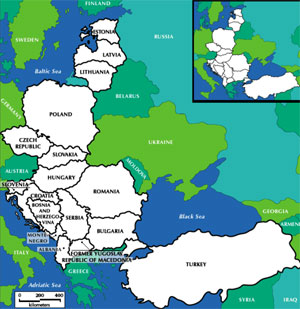THE PROGRAM
July 5 - August 5, 2012
The fourteenth annual summer program in Romania and Central Europe is a four-week session at Babes-Bolyai University in Cluj-Napoca, designed to give participants a comprehensive view of the rich and unique cultural history of Pre/Post Communist Central Europe.
It combines features of a traditional study abroad program and excursions, with emphasis on language, history, politics, cultural studies, and cultural geography, among other academic disciplines.
The classroom work is completed by an intensive program of guided visits to museums, historical sites, and other outstanding centers of European cultural heritage and by a one week cultural trip to the capitals and important cities of the former Austro Hungarian Empire: Budapest, Vienna, Prague and Bratislava. Also included in the program are visits the Black Sea and the Republic of Moldova.
Poster for 2012 Summer Program is fourthcoming.
LIVING ACCOMMODATIONS
While in Romania, housing is based on double occupancy in traditional dormitory rooms with private bathrooms. During excursions abroad, students will be housed in student dormitories or hostels.
LOCATIONS
THE BLACK SEA: Travel to the historical town of Constanta, a feminine replica of Constantinople, to partake in a city tour, visit the mosques, and see Ovid's statue. Stay overnight in Mamaia, one of the Romanian Black Sea resorts.
TRANSYLVANIA: The capital city of Transylvania, Cluj-Napoca, where the ASU program is located, is a multi-ethnic, multi-cultural city of about 400,000. Situated in the northwestern part of Romania, Cluj is built on the site of a Roman castrum, half-way between Bucharest, the capital city of Romania, and Budapest, the capital city of Hungary. It holds Gothic and Byzantine style churches, nearby monasteries, and an old downtown area, with medieval, Baroque and turn of the century buildings. In addition to Cluj, the program will include visits to other cities of Transylvania, such as Sighisoara (the birthplace of Dracula) and Bran, to visit Dracula's castle. Also included is a three-day stay in Bucharest, the capital of Romania, to visit Ceausescu's People's Palace, currently housing the Romanian Parliament, and numerous museums and cultural sites, as well as a two-day trip to the painted, medieval monasteries of northern Moldavia. |
CULTURAL TRAVEL
IN EAST - CENTRAL EUROPE
An essential part of the academic program, the cultural trip will include guided visits to the former capitals of the Austro-Hungarian empire:
BUDAPEST, sightseeing tour of the Hungarian capital, the Buda and Pesta sides, along the Danube River, the old Synagogue, and traditional dinners with gulash and gypsy musicians for two nights.
VIENNA, sightseeing and visit to Schoenbrun Castle,summer residence of the Hapsburg royal family, as well as dining in the Grinzing, the traditional Viennese
woods made famous by Johann Strauss's music.
PRAGUE, a visit of the city, with sight-seeing/walking tours of the Old Town Square,
Mala Strana (The Little Quarter), Charles Bridge, the Hrad and the Balustrade Theatre where dissidents actors led by Vaclav Havel began their protest against enforced Stalinism in 1977.
BRATISLAVA, sight-seeing tour of the new Slovak Capital, including the Old City and the famous St Martin's Cathedral where the Habsburgs monarchs were crowned.
The program also includes visits to Bulgaria (The Black Sea Coast and seaside resorts, Varna and Albena) and to the Republic of Moldova, a former Soviet region of the USSR.

|
COST OF THE PROGRAM
The program fee for summer 2012 is $2,848 (subject to change) which includes: housing, 2 meals per day, organized cultural travel to all these countries, museum fees and guided tours. There is no difference between instate and out of state tuition. Not included: Tuition for a minimum of 6 credit hours, airfare (approx. $1,100), and personal expenses.
The program may allow for time which can be spent in non-program activities. Participants may wish to travel, sightsee or participate in activities or events in which they have a personal interest.
Please note that the participant is fully responsible for making arrangements and for all costs of transportation, lodging, food and additional expenses associated with any non-program activities.
ELIGIBILITY
The program is opened to qualified students interested in Romanian language and the culture and politics of Central Eastern Europe who desire to study, travel and experience different customs, foods, and ways of life. Students from other US universities are encouraged to apply. Students signing up for the program do NOT need to take Romanian language courses.
Applications are currently accepted through May 15, 2012.
|

